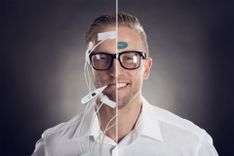What is the Internet of Medical Things?


The Internet of Things is completely transforming the way healthcare is provided. Although it has been a relatively late adopter, the healthcare industry and all its allied sectors have been embracing IoT technology in practically every step of the healthcare process . In this article, we broadly examine the scope of the Internet of Medical Things, explore what it entails and go through some of the key trends and challenges in the IoMT world.
The advent of digital technology has disrupted practically every industry on earth. Healthcare, on the other hand, is one behemoth of an industry that seemingly resisted digitalization for the longest possible time. Accounting for about 10% of the global GDP, it was a surprise to many that healthcare with all its associated industries, lagged behind most other sectors when it came to embracing a more data-driven approach.
Today, however, the healthcare industry is confronted with a rapidly changing landscape, in which it faces dramatically new challenges - a large and ageing baby-boomer population, a sharp rise in the incidence of patients with multiple chronic conditions (largely lifestyle-associated) and the growing problem of physician shortage; Add to this the monumental costs associated with healthcare throughout the world, and you have a system that is screaming for a revamp.
The world of healthcare and medicine is in dire need of an upgrade. Digitalization promises to bring with it, an entire host of improvements to healthcare - lower costs, better diagnostics, improved work conditions for physicians and medical workers and an overall higher standard of care for patients.
The healthcare industry, under immense pressure from the aforementioned challenges, has now started embracing digitalization in the earnest. Nevertheless, the industry has been glacial in its adoption of internet technology and the signs of an IoT revolution are not as apparent or radical as might be the case in other industries.
What is the Internet of Medical Things?
In previous posts, we have spoken, at length, on the Internet of Things (IoT). In its essence, the IoT is based around the concept of “ubiquitous computing” - i.e. moving away from the idea of traditional “computing devices” (such as tablets, PCs etc) and integrating computing with life at large.
It follows then, that the Internet of Medical Things (IoMT) is just that, but for medical devices. Far from being a restrictive category, IoMT itself is an umbrella term that includes a variety of different types of devices, employed at various stages of the healthcare process and in a number of unique capacities.
The underlying principle behind all IoMT devices is this - they collect, aggregate and employ data in order to streamline processes and optimise outcomes in any of the several steps involved in medicine.
In reality, this could refer to anything from technology that optimises accounting at a large hospital or a sophisticated system of sensors that monitors patients in real-time, all the way to the smartwatch on your wrist.
Why is IoMT important for healthcare?
As we mentioned in the first section, the healthcare industry is dealing with novel challenges the likes of which it hasn’t encountered in the past; or at least not at the scale in which we are witnessing them now. In most of the developed world, the costs associated with healthcare are absolutely skyrocketing. But that’s not all -
Medicine, as it is predominantly approached around the world, is a sector that is thoroughly steeped in conservatism. The stakes are simply too high and so it somewhat stands to reason that the healthcare industry has been characterised more by caution than a keenness to evolve.
But in today’s world, healthcare is starting to find its structures and practices outdated in many ways. There has been an alarming rise in chronic, lifestyle-associated health conditions and autoimmune diseases and the healthcare industry has had to turn to technology to be better equipped against these massive challenges.
There are a number of problems with the way medicine is organised and practised currently. Let’s take the notable example of patient records - most physicians spend over two-thirds of their time recording and managing patient data. Overall, the healthcare setups of the world have come to view it as something of an inevitability. If it wasn’t pitiable enough that highly educated and highly skilled professionals such as physicians, who spend close to a decade preparing themselves for a career in medicine are forced to misallocate so much of their time, the disjointedness of these datasets is an even bigger problem.
A patient’s records, in most current healthcare systems, present a “siloed” and fragmented picture of their health. This is far from ideal, especially given the fact that our analytics capabilities have grown so exponentially in the last few years. Various institutions use different kinds of processing systems to collect data. In many cases, these datasets are mismatched and it’s not feasible to integrate the data contained in them. This is incredibly wasteful and painfully expensive - a survey conducted by MeriTalk claims that “leaky” data integration could account for a staggering $342 billion in cumulative losses, every year!
Here are some more figures to drive home the point - About 62% of all laboratory tests and 35% of radiological examinations are not followed up on. This has a cascade of deleterious effects, not least of all, missing key diagnoses.
It doesn’t take a rocket scientist to figure out that our data processing capabilities and sophisticated analytical tools ought to be deployed in our healthcare setups. Physicians and care providers should be able to harness the full might of advanced analytics when it comes to making medical decisions for their patients. IoMT promises seamless and integrated access to relevant data, providing a more reliable basis for clinical decisions.
Even on the best of days, given the most ideal conditions, medicine is far from a rigid, hard-and-fast science. Even the most seasoned physician would be quick to admit that there are cases and patients where the picture doesn’t quite fit. After all, the amount of information an average physician has to synthesise and apply on a daily basis is staggering. The reality of the medical profession, which might be hard for an outsider to swallow, is that there is a lot of scope for human error. Much as we would all like our physicians to be infallible, they aren’t. In fact, it’s even churlish to expect that. Nevertheless, as things stand, the reality in most healthcare setups around the world is that a disproportionate share of both the responsibility and liability for a patient’s well-being rests on the physician.
A more digital approach to healthcare would help us build more sustainable and well-balanced protocols, where crucial decisions are not subject to confounding variables like a doctor’s energy levels or fear of a malpractice suit. IoMT allows us to envision a healthcare model where a higher proportion of clinical decisions are “clean” and based on empirical facts.
Throughout the world, more and more hospitals and healthcare institutions are adopting IoMT technology in a bid to cut down costs, improve patient outcomes and offer more customised and patient-friendly modalities of treatment. There is wide consensus among experts within the healthcare industry that adopting IoMT is in the best interests of all the vital stakeholders within the industry - authorities, investors, manufacturers, healthcare providers and patients. The needs of the healthcare industry are evolving rapidly and there is very little disagreement on the fact that the future of medicine, as we know it, is definitely going to be digital.
What will this healthcare revolution look like?
We never get tired of speaking about how “wide” a term “internet of things” is. The same is true for the Internet of medical things. This really is just an umbrella term to speak of all the disparate developments that are currently underway in the healthcare world and all its allied industries. In many ways, you are probably already availing the benefits of IoMT, without identifying it as such.
After all, every time your diabetic aunt uses her blood glucose monitoring device or you put on your heart rate monitor before your daily run, you are technically using an IoMT device. This is to say that IoMT is actually a massive category which includes all sorts of technologies and innovations, from consumer wearables all the way to cutting edge robot surgeons!
In many instances, this healthcare revolution that is underway, has already started manifesting itself - for instance, technologies like the Cyberknife (which is being used in advanced brain surgery) and robotic prostatectomies, have garnered quite a lot of mainstream attention.
There are great leaps being made in the field of medical imaging and diagnosis. By combining the power of the Internet of Things (IoT) and Artificial Intelligence (AI), we are able to make quantum leaps in terms of accuracy and as a result, more precisely targeted therapeutic interventions.
For many years, data scientists and engineers have been using “digital twins”. A digital twin is essentially just a virtual replica of a physical device, which is used to run simulations and tests. Digital twins are hugely helpful in the optimisation of manufacturing and allow for the implementation of effective feedback loops. In the near future, we could be doing the same with people. Computerised models of human bodies are already being used by medical researchers to develop more personalised treatment strategies and to simulate outcomes beforehand. In the future, we could be using digital twins to predict individual risk-scores for specific ailments and also in disease prevention.
This is part of a larger paradigm-shift that can increasingly be seen in the ethos of the medical community - a move towards preventive medicine. In the light of the current Big Data boom in healthcare, we are definitely looking at a future where AI is going to be used to sift through billions of health records and detailed bio-profiles to find missing links and heretofore unknown insights. Doctors will be able to detect diseases earlier and more reliably. And then, when you consider the billions that are being poured into genomics and other bio-tech oriented firms around the world, we have a clear picture of how the IOT revolution is driving the healthcare industry’s focus towards preventive care.
Remote monitoring boom
The use of health-trackers and wearables that transmit patient data digitally, is exploding.
“Soon, wearable-collected data will become the most important and prolific source of real-time health data that we will have” says Tom Davenport, an Information Technology professor to Harvard Business Review.
The market for patient-data devices has never been larger. Within the healthcare industry, this is a vertical that includes everything from smart beds to smart temperature monitoring devices. Fueled by advancements in ultra-low power sensors and energy harvesting technologies, patient-data monitoring gives the individual unprecedented autonomy and agency in participating in the management of their health. More pertinently, this means that crucial data is available when and where it is most needed. There is also the happy side effect of these devices motivating patients to take better care of their health and feel more in charge of their own wellbeing.
“Soon, wearable-collected data will become the most important and prolific source of real-time health data that we will have.
Today, a high life-expectancy coupled with a higher incidence of chronic diseases is a huge challenge that faces healthcare. Remote monitoring opens up all sorts of exciting possibilities in the management of chronic conditions. Especially in countries like the United States, where in-patient care is often prohibitively expensive, remote monitoring could potentially allow for a patient to spend less time in the hospital. It opens the door for treatment to be expertly managed by a doctor, all from the comfort of home. This would make for a more seamless, connected and coordinated treatment modality that bridges the gap between in-patient and at-home care. In fact, just being in a hospital setting is a massive risk factor for vulnerable patient groups, like seniors, those receiving chemotherapy etc, because of the increased risk of nosocomial (hospital-acquired) infections.
Healthcare 4.0
The latest stage in the evolution of medicine is being termed Healthcare 4.0. Huge volumes of data are making their way into clouds from primary care practices, diagnostic centres and even the bodies of patients!
And it’s not just massive amounts of “dumb” data either. Healthcare 4.0 is about transforming these astronomical amounts of data into clear, actionable insights and applying them in real-life settings. This is a phenomenon that is very much happening all around us, as of today. Remote care and telemedicine are already very much a reality of the healthcare landscape around us.
And the most exciting part is that this innovation is happening in real-time. It is an exciting time to be in healthcare because it seems like just about every other day, there is a breakthrough in precision medicine or medical imaging.
IoT technology seems to be beckoning towards a more optimistic future where we are able to more effectively overcome some of our present shortcomings in providing timely and reliable healthcare.













